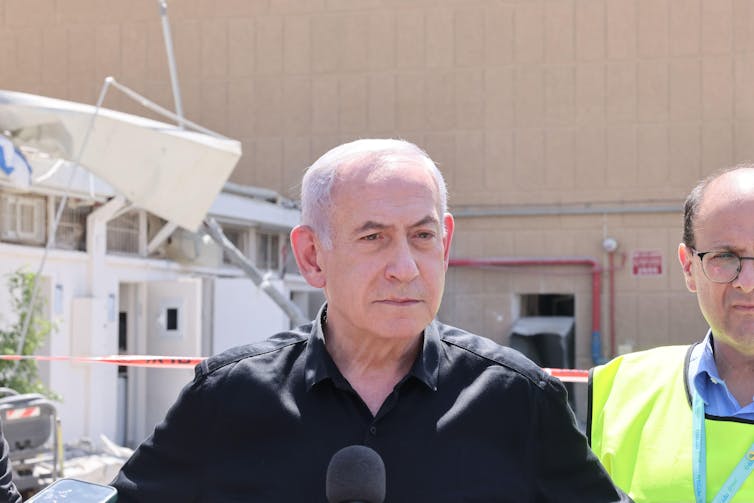Operation rising lion has been a concerted effort by the Israel Defense Forces to degrade Iran’s nuclear programme. Launched on June 13, the operation has targeted key nuclear installations, logistical hubs and Iranian nuclear scientists, key intelligence and military personal.
Israel has justified the attack by claiming that Iran was on a verge of a “breakout” in its nuclear programme. This means it would be able to break out of its commitments under the Nuclear Nonproliferation Treaty, which it ratified in 1970.
This contradicts the threat assessment briefing delivered by the director of US national intelligence, Tulsi Gabbard, on March 25 when she said: “Iran is not building a nuclear weapon and Supreme Leader Khamenei has not authorised the nuclear weapons program that he suspended in 2003.”
But whatever the veracity of claim and counter claim, Israel has been able to combine precise intelligence with the effective suppression of Iran’s air defence network. This has enabled the Israeli air force to inflict extensive damage on the uranium enrichment facility at Natanz and the heavy water plant at Arak, as well as associated research facilities in Tehran.

Get your news from actual experts, straight to your inbox. Sign up to our daily newsletter to receive all The Conversation UK’s latest coverage of news and research, from politics and business to the arts and sciences.
The attacks have also destroyed two-thirds of Iran’s ballistic missile launchers, according to the latest Israeli estimates. In response, Iran has fired salvoes of ballistic missiles at Israel, some of which have penetrated the much-vaunted Iron Dome missile defence system, due to the sheer number of missiles launched.
But despite causing between 20 and 30 civilian casualties in Israel (compared to more than 600 in Iran), and despite the fear of attack among much of Israel’s population, little strategic damage appears to have been inflicted.
Within three days of launching operation rising lion, Israel claimed complete aerial supremacy over Iran. But despite this, the key enrichment facility at Fordow, close to the ancient religious city of Qom has proved impervious to Israel’s existing military capabilities.
The facility is buried hundreds of metres inside a mountain and designed to survive a full scale aerial bombardment. All reports are that besides some limited damage to the ground-level entrance and ventilation shafts, Israeli attacks on the site have failed to affects its operational capacity.
Another enrichment facility near Natanz at Kuh-e Kolang Gaz La, or “Pickaxe Mountain,” is thought to be even deeper inside a mountain.
Only the US, with 30,000lb GBU-57 massive ordnance penetrator bomb caried by the B-2 stealth bomber is reckoned to have the capability to inflict lasting damage on these underground nuclear facilities. Israel’s prime minister, Benjamin Netanyhu, has appealed to the US president, Donald Trump, for help in destroying these nuclear assets. Trump has said he is still considering his decision.
Operation many ways
US help is clearly Netanyahu’s main option for neutralising these underground plants. But don’t rule out a ground attack by Israeli special forces. A template for how Israel might deal with Fordow was revealed last year.
Launched on September 8 2024, operation many ways destroyed an underground missile facility that the Iranian Revolutionary Guards Corps had built into a mountainside in the Masyaf area of Syria, just west of Hama and around 125 miles north of the disputed Golan Heights. This facility was responsible for producing sophisticated surface-to-surface missiles for use by Hezbollah as well as by the regime of Bashar al-Asad, Iran’s ally.
After months of surveillance, 200 soldiers from the Shaldag (Kingfisher) special forces unit of the Israeli Air Force were helicoptered to the site under the cover of a series of diversionary airstrikes. The surprise attack quickly overwhelmed defensive forces and used around 600kg of explosives to destroy the underground facility. The unit also collected a considerable amount of intelligence documents which they transferred back to Israel. There were no Israeli casualties.

Marc Israel Sellem/UPI/Alamy Live News.
Greater risk
Would Israel risk a similar operation against Fordow? The risks undoubtedly are far greater. The operation would have to be carried out at a much longer range – the enrichment facility is more than 1,000kms from Israel.
Such an operation would need to involve far more troops than operation many ways. And the operational requirement to ensure sufficient air-to-air refuelling capacity for the air force’s heavy lift “Yasur” helicopters would add a layer of logistical complexity.
But the IDF’s ability to innovate around the use of longer-range C130 transport aircraft that can land in rough areas should not be underestimated. They showed this as long ago as 1976 when mounting the famous hostage rescue mission at Entebbe in Uganda.
Also on the plus side for Israel is its air superiority. The country is also a leader in electronic counter warfare measures which would allow it to blind or jam Iranian communications.
But while the Iranian armed forces have suffered heavy blows, the ground defences around Fordow will still be formidable. To gain access to and destroy the centrifuges widely believed to be at Fordow with sufficient explosives runs the risks of heavy casualties on all sides. So the calculation Israel’s military planners would have to make is the strategic gain relative to the cost in blood.
Yet given Fordow has long been recognised by Israel as the jewel in Iran’s nuclear crown this too might be another gamble Netanyahu is willing to take in a war that, whatever its outcome, is already reshaping much of the Middle East.




